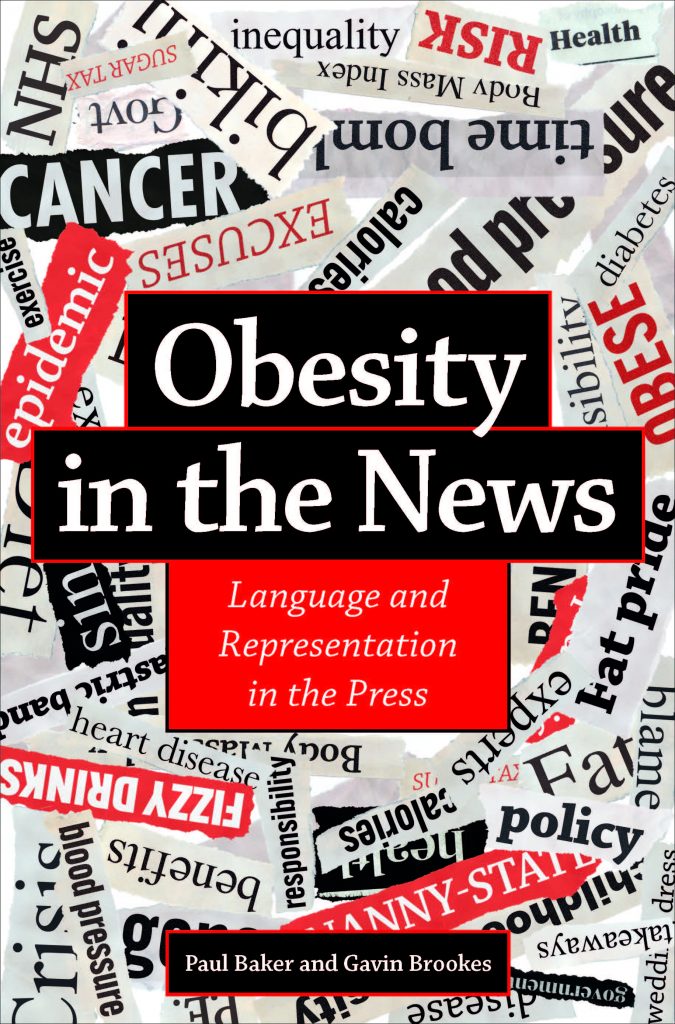
Gavin Brookes and Paul Baker
The UK has one of the highest rates of obesity in Europe. It is estimated that around 62% of the country’s population can be classed as overweight, while a further 25% can be diagnosed as living with obesity. Because of this, obesity has remained an eminently newsworthy topic for the British media, including newspapers, which have covered the issue widely over the last decade.
In a new book, titled Obesity in the News: Language and Representation in the Press, we explore how the British press use language to represent obesity and people affected by it. To do this, we collected and analysed articles from eleven UK national newspapers mentioning the words ‘obese’ and/or ‘obesity’ over a ten-year period (2008 to 2017). This amounted to almost 44,000 articles, totalling over 36 million words. We studied these articles using techniques from corpus linguistics, which provides a methods for identifying and analysing frequent words and recurrent linguistic patterns across vast bodies of digitised language data.
One question we asked was, ‘how do British newspapers frame obesity?’. We found that the newspapers in our data tended to employ three prominent ‘frames’ when representing obesity and people with it. These are: the lifestyle frame, the scientific frame, and the structural frame.
The lifestyle frame, which was the most frequent of the three frames noted above, construes obesity as something that occurs as the direct result of individuals’ lifestyle choices, such as what and how much people eat, as well as the amount of physical activity that people engage in. This frame frequently manifested in news stories which encouraged readers to change their lifestyles to lose or control their weight. Such stories include those which inform readers about diets and exercise programmes that others (particularly celebrities) have used to lose weight. In tabloid newspapers in particular, we identified numerous examples of what we term ‘redemptive weight loss narratives’. These articles present real-life stories about people (usually women) who were previously unhappy but who had become happier and more socially active after they lost weight. It could be argued that these ‘inspirational’ articles perhaps present a partial narrative, as many dieters can regain weight once they stop dieting.
Through the scientific frame, newspapers present obesity as arising due to biological factors, for example as a result of genetics, hormones or brain activity. Like the lifestyle frame, the scientific frame also focuses on the individual, though it also refers to factors that are considered beyond individuals’ control.
The third frame we identified – the structural frame – broadly presents obesity as an effect of societal structures, such as socio-economic inequalities, government policies, urban planning, and the practices of food manufacturers and marketers. In contrast to the lifestyle frame, the structural frame thus shifts focus away from individuals’ decisions and towards the influence of the socio-economic conditions in which people live. From this perspective, newspapers foreground the fact that disparities in the conditions of individuals’ lives mean that some will find it easier than others to change their lifestyle and thus influence their own risk of developing obesity.
A related question we ask in the book is, ‘how have press representations of obesity changed over time?’. When we tracked the frequencies of the aforementioned frames over time, we found that the lifestyle and scientific frames had become more prominent, increasing in frequency over the ten years we studied. The structural frame, meanwhile, decreased in frequency, receiving significantly less attention over this period. Over the period studied, newspapers were therefore became increasingly likely to employ language which framed obesity as something that relates to individuals as opposed to decisions made by politicians or businesses.
A consequence of the growing prominence of the lifestyle frame is that individuals are often blamed for developing obesity and then shamed for not making ‘sensible’ lifestyle choices to avoid and reverse the condition. One way in which British newspapers do this is to describe food and eating behaviours using religious and moral metaphors. Such figurative language is used to describe foods associated with obesity as ‘guilty’ and ‘tempting’, and their consumption as a ‘sin’, as ‘naughty’ and as ‘cheating’. The implications of such metaphors is that those who consume such foods are themselves cast as bad, or ‘sinful’, people. In this way, such evaluative language can contribute to the stigma that surrounds obesity and to the stigmatisation of those who are framed as being ‘responsible’ for their condition.
We also found that the tabloids are particularly likely to stigmatise and shame people with obesity in the ways they labelled them and described their actions. The tabloids were particularly likely to describe people with obesity using negative evaluators such as ‘fatty’, ‘blob’ and ‘lardy’, while other labels describe larger bodies and body parts in unflattering terms, such as ‘moobs’, ‘blubber’, ‘muffin-top’ and ‘bingo-wings’. Another set of terms describe their movements in unflattering terms, such as ‘waddling’ and ‘lumbering’. As well as using religious metaphors to describe food and eating, the tabloids also utilised metaphorical language to describe people with obesity, for example drawing on animalistic tropes to equate people with obesity and their consumption practices with animals that are perceived as greedy and as having undiscerning food preferences, employing labels such as ‘hog’ and ‘pig’, and describing their eating practices as ‘wolfing’ and ‘swilling’. Such articles tended to employ a mocking tone, viewing people with obesity as somewhat pathetic figures of fun. If such language had been used about a racial or religious group there would rightly be public outcry.
The lifestyle framing of obesity is a powerful one for the British press, then, and in the book we explore how this frame interacts with and shapes the press’s linguistic depictions of a range of particular themes relating to the topic of obesity, such as diets, weight loss surgery and exercise as well as how obesity relates togender and social class, and in the comments that readers leave in response to the articles on the newspapers’ websites. Yet as we have noted, this most prominent frame can also give rise to weight stigma and the shaming of people with obesity, who are viewed at best as tragic or funny, and at worst as disgusting, lazy or even desperately criminal. Since obesity has persistently been associated with a wide range of negative health outcomes, the newspapers’ focus on individuals’ lifestyle choices and the shaming language that issues from this have been argued to be a kind of ‘tough love’, intended to inspire people with obesity to change their lifestyles for the good of their own health. However, we should be mindful that such shaming is unlikely, in our view, to lead to anyone having positive and contented attitudes towards their bodies and themselves. This is of particular concern for obesity; a 2004 House of Commons report notes that people living with obesity are three to four times more likely to experience anxiety and depression, while women with obesity are 37% more likely to commit suicide.
Importantly, we should bear in mind that while newspapers can shape public understandings of issues like obesity, in order to sell as many newspapers as possible they also aim to reflect the views of their ‘imagined’ readers. Indeed, the attitudes towards obesity which dominate across the pages of the British press are not unique to newspapers but can be found in countless other contexts across society. The language we use when we talk about health issues like obesity is important as it can shape our attitudes towards those issues, including how those affected think about themselves. Language use which propagates weight stigma and which shames people with obesity is unlikely to create better physical and mental health within our society. In this book, we argue that any improvement to the public’s health will only come with a change in attitudes towards obesity and people with it. Changing the language that we use to talk about obesity could provide a good starting point for such a change in attitudes. However, it is important that we not only critique the language of powerful communicators such as the mainstream media, but also reflect critically on the language that all of us use, every day.
Out now: Obesity in the News: Language and Representation in the Press

Latest Comments
Have your say!